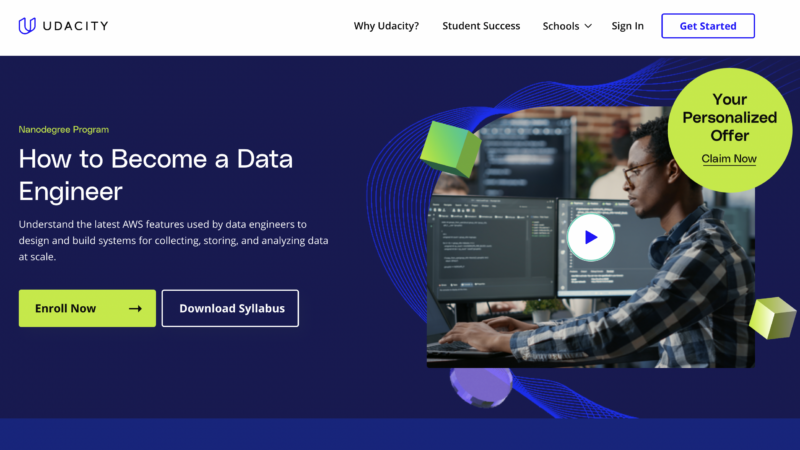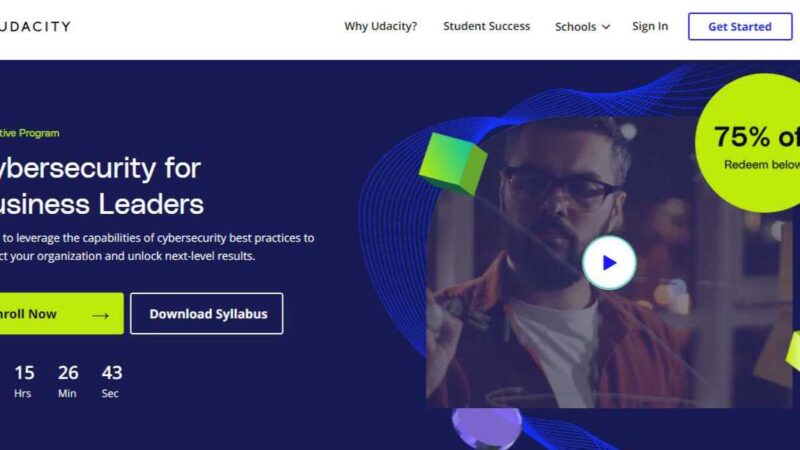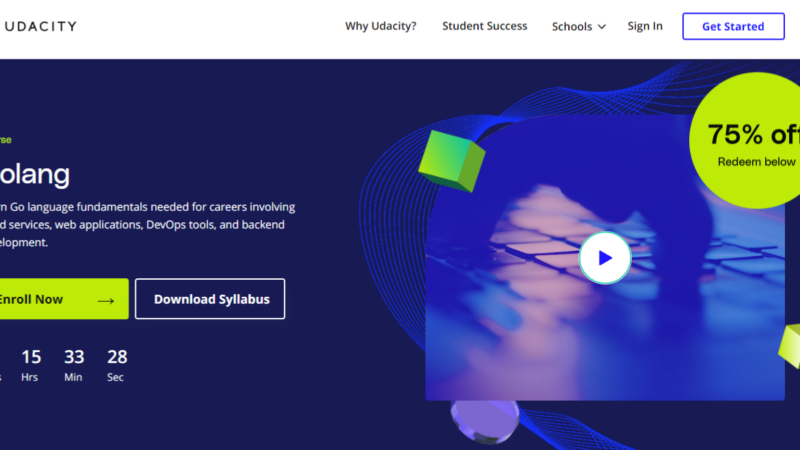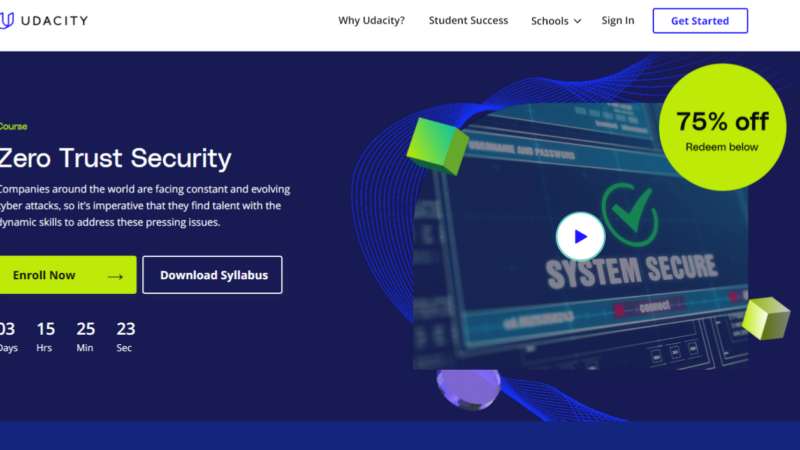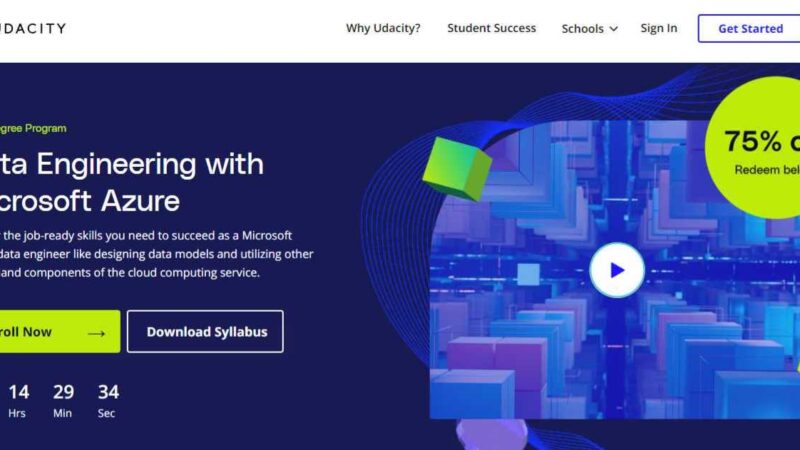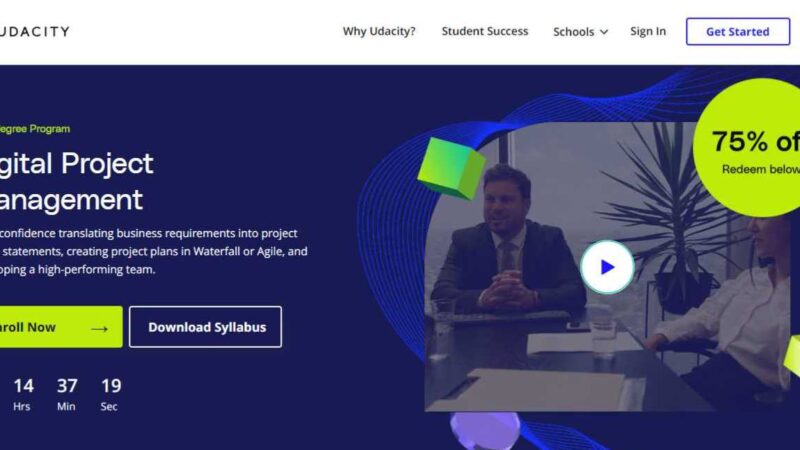Udacity Data Structures and Algorithms Nanodegree Review

Data is a powerful tool. Those with the ability to manipulate and construct it into useful information are at an advantage, in-demand in the market. Working with structure and complex algorithms comes with the power to solve data driven problems, giving companies one less thing to worry about as they make conversions to do business digitally. Creating a strong foundation of the knowledge needed to land a job in the field is crucial, one that can be started with the Data Structures and Algorithms Nanodegree from Udacity.
We are here to bring you an inside look of the course and the job market, in an attempt to reveal if it is the right choice for you. We’ll introduce you to the academy and instructors plus, break down the course and curriculum before getting to an analysis on job outlook. By the end, you’ll have all the info you need to decide if Udacity, and this nanodegree, are the right move for you and your new career.
About Udacity
You might have heard about Udacity because of their in-depth courses or one of their many powerful partnerships. Though they are taking the online learning abilities to never before reached places, they started off quite small and with a heart-warming idea. Professors from Stanford University wanted to digitalize courses, making them available for anyone that wanted to start learning technological concepts. Since 2012, they’ve worked to keep their curriculum current while creating new courses with industry leaders. They offer courses from introductory to advanced, some free and some with certifications that can be used to land you your dream job. These certifications are known as nanodegrees, which are mini-courses set to take months instead of years to complete.
Nanodegree Perks
Each nanodegree is carefully constructed to focus on one area in the field. Apart from the knowledge needed to break into the field, they come with projects that will give you your first hands-on projects.Included in each nanodegree are a few extras that seem to set Udacity apart from other online academies. These extras include:
Flexibility
Your schedule is yours to create. You will only be given a set of deadlines for some of the projects, getting the chance to learn when and where you want.
Real Projects
Each and every nanodegree comes with projects included to apply the knowledge you’ve learning. The academy tries to keep theses projects as close to the projects you’ll see out in the industry as possible, sometimes creating them in collaboration with top tier companies.
Mentorship
Technical problems happen. When they do, you’ll have someone to call with the knowledge to keep your learning going.
Community
Udacity’s student forum is a place for students to connect. You can reach out to others in search of support, help or, just to bounce ideas around. You may wind up making some lasting connections, some which will follow you well into your career.
Career Prep
Also included with each nanodegree is an amazing career prep team. They will look over your resume and professional social pages, making them stand out. Before the big day, you can partake in a mock interview, where you will be given feedback that you can use. If all this were not enough, upon successful completion, Udacity will send your resume out to more than 95 companies and connect you with recruiters in the career database.
Meet the Staff
The extras might make the academy stand out a bit more but, the academic staff definitely puts the icing on top. Each and every member is carefully selected, generally standing out in their field. For this course, you’ll be led by:
Brynn Claypoole
Brynn is working with Genomics as of late, which brings her industry experience to widely expanded horizons. Before that, she worked as a data analyst for Udacity then moved to Facebook as a data engineer.
Abe Feinberg
Abe is a former university professor. At Udacity, he also puts his passions into play, making harder concepts easy to pick up and grasp. On top of that, he is one of the content developers on the squad, creating interactive and in-depth lessons.
Kyle Stewart-Franz
Kyle has a unique beginning, learning concepts of development on his own. He now develops projects for Udacity nanodegrees including Blockchain and Self-Driving Car Engineer.
Before you Begin
During this course, you’ll be using Python and working with complex data structures. Due to their advanced nature, you’ll need to have a few things before you begin. As a recommendation, Udacity has listed the following as prerequisites:
- A good grasp on programming with Python
- Basics of algebra
If you’ve never worked with Python before or are in dire need of a crash course on Algebra, you can check out Intro to Programming or free courses. These will help you build a foundation, one that you’ll be able to load more concepts on as you make your way through the course.
The Course
Throughout the course, you’ll be working heavily with algorithms to solve problems. In each of the four sections, you’ll be able to put your knowledge to the test, learning how to work with data structures and multiple algorithms to solve a wide range of issues. The sections and an overview of their content is listed below.
Warm Welcome
Your welcome to the course comes with an overview plus a Python refresher. The first concept you will work with will be taking apart open-ended problems, learning a bit more about each piece. This will help you in understanding the complex idea of time and space. You’ll use these ideas to help you unscramble computer science problems for your first hands-on project.
Data Structures
Here, you’re getting your hands on the data, learning how to work with it giving it new shapes and forms that will result in useful answers. You’ll get to see different types of data structures, learning which can be used effectively to solve different types of problems. You will take this knowledge and apply it in the end of section project, solving different open-ended problems with the best data structure.
Basic Algorithms
You will meet the algorithms that make problem solving a breeze. You’ll be introduced to the concepts of searching and sorting, learning to determine the efficiency of each. For practice, you’ll sharpen your selection skills, learning how to choose and tweak algorithms to make them work for you. Work with a variety of problems, using your experience to advance your algorithm knowledge in the next section.
Advance your Algorithms
In this section, you’re introduced to more complex algorithms, some that can accomplish very powerful solutions to more excruciating problems. You’ll work with graphs and get a glimpse at more dynamic programming, including storing. At the end, you’ll build an algorithm with the power to plan routes similar to that of Google Maps. Your goal is to map the shortest distance, using a combination of in-depth thinking and algorithms to successfully complete the project and the course.
The Time
One of the Udacity perks is flexibility. While some projects come with set deadlines, you can take as much time as you want or need as long as you stick to them. However, this could be a bit of a trap, as you’ll want the knowledge required fresh on your mind to help you through some of the more complicated projects.
Apart from keeping your new knowledge fresh, you might also want to keep track of the time it will take you for your wallet’s sake. The time you take directly affects the cost so, be careful before you take your sweet time. The academy estimates that, at 10 hours per week, it would take 4 months to complete. This estimate is used to give learners an idea and also to create a Udacity offer that makes the course cost lower.
The Cost
If you’re looking to take this course now or in the very near future, you’re in luck. Udacity is currently running a promotion, where you get one month of access absolutely free. This makes the course and its content much more attractive, giving you the curriculum, the staff and all the perks at a lower price than ever. The total for the course depends on which method you choose to pay, of which there are two. Before we get to those, we would like to suggest that you take a look at your schedule, creating a timeframe that you can stick to. This will help you choose the best option, keeping you from spending more than you bargained for.
Pay per month
With this option, you’re paying for access by month. You will begin, thanks to the promo, with your first month free, paying for each month after that. Each month comes with a price tag of $359, which could eventually add up if you take too long.
Bundle up
Udacity’s estimate is used to create a bundle deal. The total is calculated with a 15% discount thrown in plus, with the current promo, you’re paying for 3 months of access for a total of 4. With this option, each month comes to about $232, which is right under $700 total. This is to be paid up front but, comes with a great discount if you’re confident you will finish the course in the estimated time.
Learner’s Perspective
There are a ton of graduates and learners that have trusted in Udacity. Overall, the academy has a solid reputation, receiving praises from several former and current enrollees. This course in particular has a good reputation, and here is what a few learners had to say.
“The pedagogy of teaching is giving a feeling like learning in an educational institute. I had never been to such intricate courses with intense practical methodologies. However, if you are not aware of this cognitive classes I think you are missing something larger than the knowledge you have.” – Vasu P.
“At first i could not understand from where and how to solve the problems but after revision my own notes learned from Udacity classroom it helps me to solve my problem and enhance my confidence.
It is really a point to point learning platform and I enjoyed a lot in my classroom.” – Sahil S.
The Job Market
Data is a powerful thing. Those with the skills to turn it into understandable and useful information are in demand. This is said to increase, as more companies rely on their online presence to increase business and user satisfaction. A review published by Morning Future claimed that the field of data analysis would create 700,000 positions for new recruits in 2020. Taking the view more in depth in the field, ITJobsWatch.comclaimed that the amount of permanent jobs is on the rise as well as the average annual salary. This is about $65,000 per year, which increases depending on your company and your skillset.
Data science is continually ranked as one of the most in demand markets out there, making it an attractive field and career to get into. Beginning your skills now comes with a lot of advantages, leaving you time to expand your knowledge way before the peak is ever reached.
Before you Go
The job market surrounding data isn’t going anywhere. As a matter of fact, it is quite possibly still in its earlier stages, making it a great time to start growing your skills. With the skills necessary to create and deploy algorithms that solve complex problems, you will become an asset to several companies, especially since there is a continued emphasis on going digital.
To begin gaining the skills needed, a course like that at Udacity can be a great option. We like the academy because of its reputation and for the fact that the courses go in-depth and come with hands-on application. Plus, each and every nanodegree comes with added perks, which all come together to increase success of students and graduates as them make their way out into the work world.
